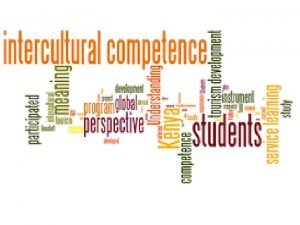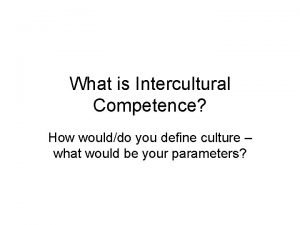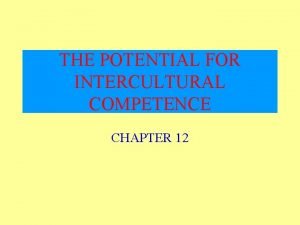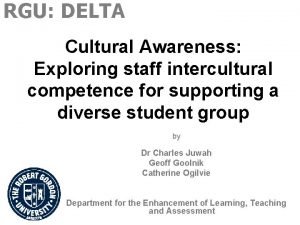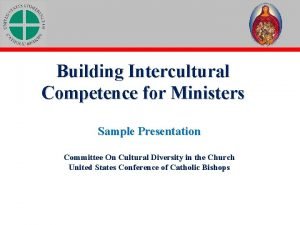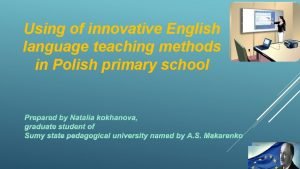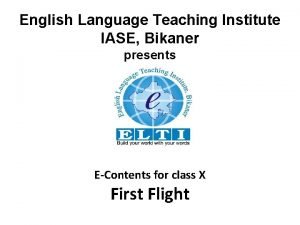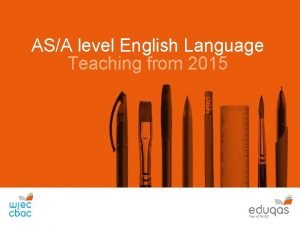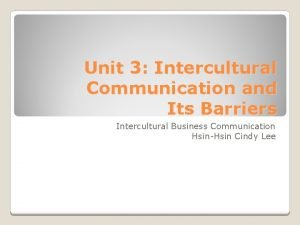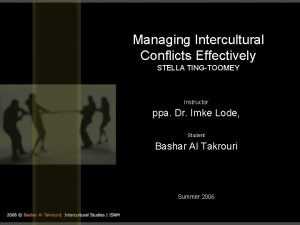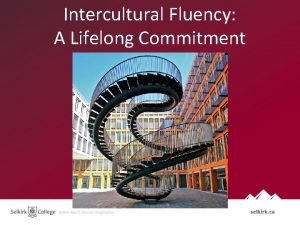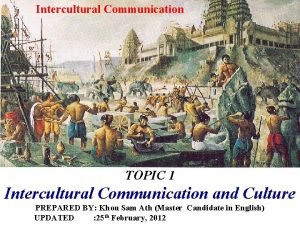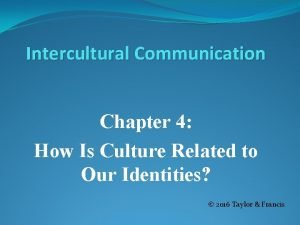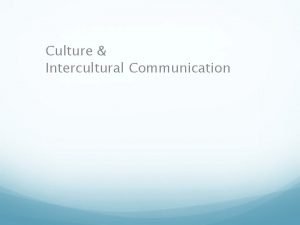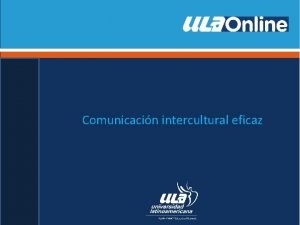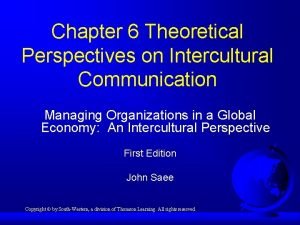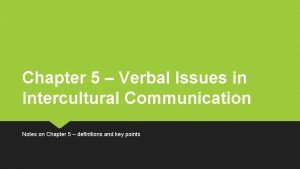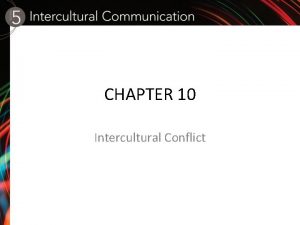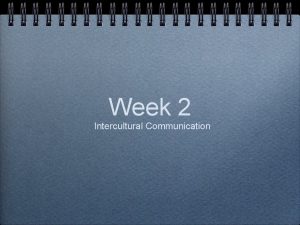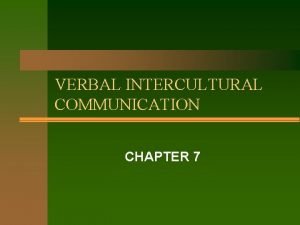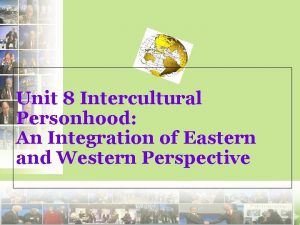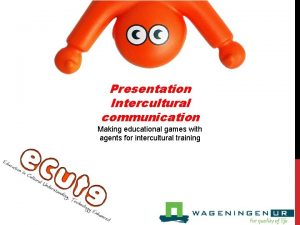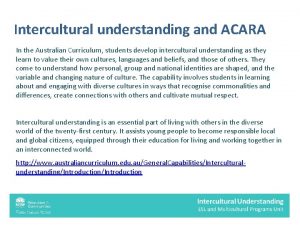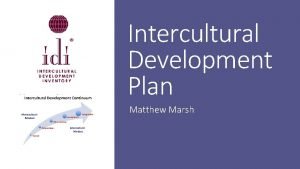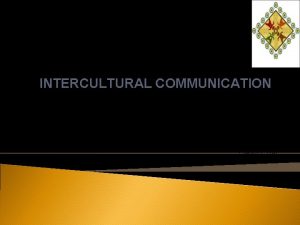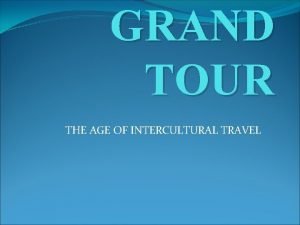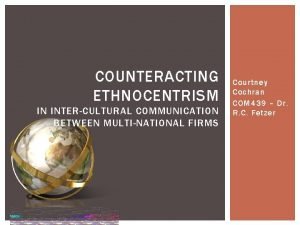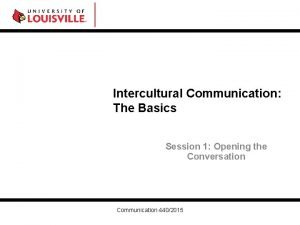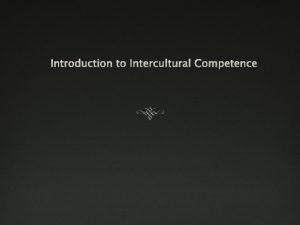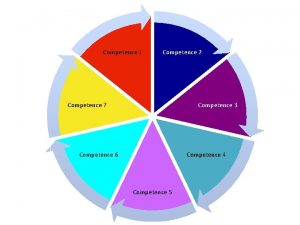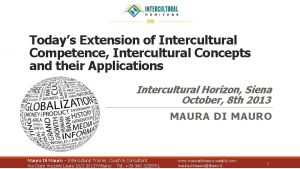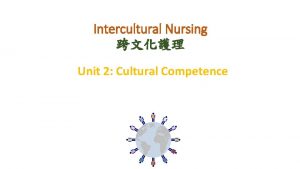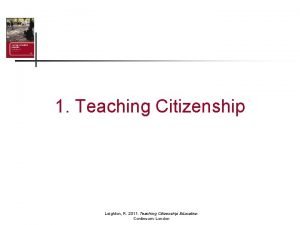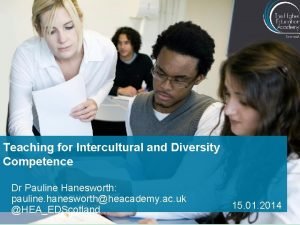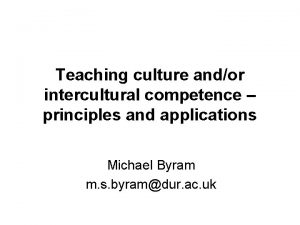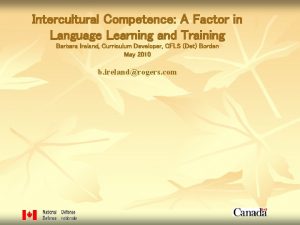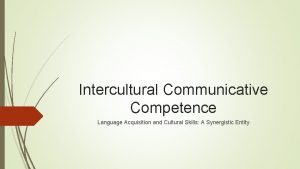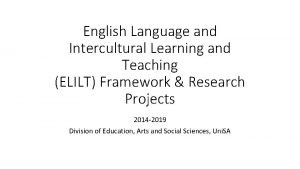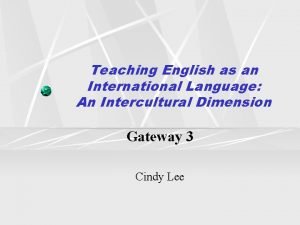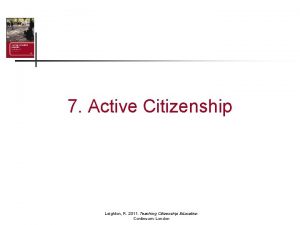Intercultural Competence for Citizenship in English Language Teaching





































- Slides: 37

Intercultural Competence for Citizenship in English Language Teaching: a Portuguese study 3 rd International Conference on Teaching English as a Foreign Language FCSH, 27 th November 2010 Lisbon Sofia Araújo (MA English Studies)

babel (n. )- a confusion of voices and other sounds p Why n are all these languages so confusing? Language and Culture To understand language, you have to understand that differences in language go well beyond what you find in the grammar and the dictionary. Communication in today’s world requires culture. Problems in communication are rooted in who you are, in encounters with a different mentality, different meanings, a different tie between language and consciousness. Agar (1994: 16/23)

Language expresses and embodies cultural reality: p people create experiences through language p facts, ideas, experiences that others share p tone of voice, gestures and facial expressions, etc.

Culture is like an iceberg (Ting-Toomey, 1999: 10) p It hides much more than it reveals* n The multilevel nature of culture Language, food, appearance… Communication styles, beliefs, values, attitudes, perceptions… Edward Hall (1990: 29)

Languages spread across cultures and cultures spread across languages* p Linguistic and cultural practices change n Transnational patterns of migration and markets p. Transnational dynamics in a global perspective Risager (2006: 2)

Culture is the thousand people sitting in your seat* p Communication is of key importance in the modern world n Factors: Globalisation International Migration (Appadurai’s ethnoscapes and global flows) enhanced culturally diverse societies *Pederson (in Sen Gupta, 2003:

Living in the Global Ecumene* p Overlapping communities of fate (Held, 1999: 445, 2001) Communities local regional national international virtual *Hannerz (1992: 217)

Intercultural Communication and Citizenship p However it seems as if the intercultural encounter is an inevitable part of the Global Village, and therefore our duty as educators is to strive towards developing a suitable pedagogy for this experience. Sen Gupta (2003: 171) The idea of “Intercultural” underpins related concepts Education for citizenship is one response to the political and social realities of globalisation

Cosmopolitan democracy and citizenship education: p bringing to class the wide variety of experiences that learners can bring to their education n educating for citizenship to citizens-in-waiting Cosmopolitan citizenship: a way of being citizen at any level Osler and Starkey (2003, 2005)

local regional national international virtual

The concept of citizenship is pivotal n Schools as settings for socialisation and development of citizens n Central concern- strengthening social cohesion and more active participation by citizens in social and political life

Plurilingualism: an important tool for educating for democratic citizenship p Language education: flexible content n ranges from literature to debates n media studies n or diversified activities on focus topics n

The transnationality of English p The world has opted for English Hindmarsch, (1978: 42) p p p An amazing world resource* Unprecedented possibilities for mutual understanding* An opportunity to enter the languaging of others# A gateway to other cultures and languages Intercultural and citizenship skills can be exercised *Crystal (1997: xiii) #Phipps and Gonzalez (2004: 3)

English as a tool for citizenship p English as an international language and a cross-cultural communication tool p An asset: n When dominant languages such as English are learned subtractively, … they become killer languages. The task for users of English is to stop it being a killer language and change it to an additive asset. Skutnabb-Kangas, 2004

Intercultural Competence for Citizenship in ELT

Learning to live together p Bringing together the hitherto separate concerns of citizenship and language teachers (Byram, 2006: 127) + p Development of a sense of world citizenship (Moreira, 2006) + p English as (…) a way of accessing multiple cultural worlds (Moreira in Vieira, 2002: 127) + p Exposing students to other equally worthwhile ways of life (Bell, 1995: 12)

The intercultural English teacher p Concerned with other languages and cultures, besides English speaking; Encouraging democratic and cosmopolitan citizenship p Less concerned with the grammatrical and structural components of the language teaching process p Integrative view of language teaching: p Educating the person as a whole and not just the academic p Global concerns p Learning how to think and act globally at a local level p

Questionnaires: teachers and students

Teachers’ results p Cultural contents and linguistic skills – no consensus; p Learning to communicate with people from different cultural backgrounds; p Intercultural and Citizenship education are central concerns in ELT;

Students’ Results: Grammatical rules: the most important side of learning English; p Desire to learn more about other peoples and lifestyles; p Cultural contents – use the course book p Objectives p A better job perspective

Course books: results Course book is used every day; p Used when approaching cultural topics; p Cultural contents of the course book meet their expectations; p Need to prepare aditional teaching materials; p Habitual cultural contents in course books: English speaking countries. p

p We live in a world of things seen, (…) we “swim” in a sea of images (…) p (…) these images help shape our perceptions of the world and ourselves. Berger (1998: 1/4)

Course books – pictorial content p Log in 10 n n n 5 units 240 pages 304 pictures p New Aerial 11 n n n 4 units 224 pages 327 pictures p Categories n Euro-American n Other cultures n Civic and social issues

Euro-American culture Famous people p Teenagers p Films p Music p Gadgets p Food p Activities p Objects p Familiar, contemporary and mediaconstructed p

Other cultures p Other cultural realities Civic and social issues p p p p Citizenship education Environment Racism Discrimination Xenophobia The homeless Immigration People with special needs

Log in 10 – 304 pictures Euro-American culture – 302 pictures p Examples: 2 - Log in page 15 - “The Holiday” film- Jude Law and Cameron Diaz 21 - Log in 10 page 167 18 - Log in 10 page 170 - Destiny’s Child 25 - Log in 10 page 214 11 - Log in 10 page 54

Other cultures – 1 picture 22 - Log in 10 page 179

Civic and social issues – 1 picture 6 - Log in 10 page 29

Log in 10 – Overview Fig. 59 - Log in 10 - Overview

New Aerial 11 – 327 pictures Euro-American culture – 282 pictures p Examples: 3 - New Aerial 11 page 49 - U 2 5 - New Aerial 11 page 28 13 - New Aerial 11 page 62 22 - New Aerial 11 page 139 16 - New Aerial 11 page 84

Other cultures – 20 p Examples: 7 - New Aerial 11 page 20 24 - New Aerial 11 page 128 6 - New Aerial 11 page 27 23 - New Aerial 11 page 126 - Vietnam 17 - New Aerial 11 page 85

Civic and social issues – 25 pictures p Examples: 9 - New Aerial 11 page 16 8 - New Aerial 11 page 33

New Aerial 11 – Overview Fig. 64 - New Aerial 11 - Overview

Log in 10 and New Aerial 11 overview Fig. 65 - Log in 10 and New Aerial 11 overview

Conclusion p Rethink pictorial content of course books p Appropriate training for teachers p A new perspective: English teacher Intercultural teacher of English p English as a school subject: English Intercultural English

Bibliography p p p p p AGAR, M. (1994) Language Shock – understanding the culture of communication, New York: Harper. Collins. BELL, G. H. (ed) (1995) Educating European Citizens, London: David Fulton Publishers Ltd. BERGER, Arthur A. (1998) Seeing is believing- An Introduction to Visual Communication, USA: Mayfield Publishing Company. BYRAM, M. et al (ed) (2006) Education for Intercultural Citizenship- Concepts and Comparisons, Clevedon: Multilingual Matters Ltd. CRYSTAL, D. (1997) English as a Global Language, Cambridge, UK: Cambridge University Press. HALL, E. (1990) The Silent Language, New York: Anchor Books. HANNERZ, U. (1992) Cultural Complexity - Studies in Social Organization of Meaning, New York: Columbia University Press. HELD, D. et al (1999) Global Transformations – Politics, Economics and Culture, Stanford: Stanford University Press. HELD, D. (2001) Violence and Justice in a Global Age (online) http: //www. opendemocracy. net/forum/strands home. asp on 14 th September 2007. MOREIRA, G. (2006) “Globality and Interculturality in the Teaching of English”. in Bizarro, R. (ed) A Escola e a Diversidade Cultural, Lisboa: Areal Editores. MOREIRA, G. (2002) “The socio-cultural dimension: learning – teaching – programming” in VIEIRA, F. (ed) Pedagogy for Autonomy and English Learning: Proceedings of the 1 st Conference of the Working Group – Pedagogy for Autonomy. Braga: Universidade do Minho. OSLER, A. & STARKEY, H. (2003) “Learning for Cosmopolitan Citizenship – theoretical debates and young peoples experiences”. Educational Review, Vol. 55, No. 3, pp. 243 -254. OSLER, A. and STARKEY, H. (2005) Changing Citizenship. Democracy and Inclusion in Education, Berkshire: Open University Press. RISAGER, K. (1999) “Language and Culture: Disconnection and Reconnection” in VESTERGAARD, T (ed) Language, Culture and Identity, Aalborg, Denmark: Aalborg University Press. SEN GUPTA, A. (2003) “Changing the focus: A Discussion of the Dynamics of the Intercultural Experience” in BYRAM, M. et al (eds) Intercultural Experience and Education, Clevedon: Cromwell Press. SKUTNABB-KANGAS, T. (2004) “Murder that is a threat to survival” in The Guardian Weekly (online) TING-TOOMEY, S. C. (1999) Communicating across Cultures, New York: Guilford Press. http: //www. guardian. co. uk/education/2001/mar/22/tefl 3 on 28 th February 2007.

Questions, suggestions, opinions p sofiaraujo 76@gmail. com Thank you
 Constituent elements of intercultural competence
Constituent elements of intercultural competence Define intercultural competence
Define intercultural competence Behavioral assessment scale for intercultural competence
Behavioral assessment scale for intercultural competence Rgu delta
Rgu delta Building intercultural competence for ministers
Building intercultural competence for ministers Citizenship competence
Citizenship competence The direct method شرح
The direct method شرح Jenis evaluasi dalam pembelajaran
Jenis evaluasi dalam pembelajaran Innovative methods of teaching english language
Innovative methods of teaching english language English language teaching institute
English language teaching institute Scaled down teaching meaning
Scaled down teaching meaning Levels of language knowledge
Levels of language knowledge Intercultural communication barriers
Intercultural communication barriers Managing intercultural conflict effectively
Managing intercultural conflict effectively Intercultural fluency
Intercultural fluency Kim's model of intercultural conflict
Kim's model of intercultural conflict Example of a low context culture
Example of a low context culture Intercultural communication questions
Intercultural communication questions Avowal and ascription
Avowal and ascription Intercultural communication youtube
Intercultural communication youtube Concepto interculturalidad
Concepto interculturalidad Kincaid's convergence model of communication example
Kincaid's convergence model of communication example Intercultural communication notes
Intercultural communication notes Kim's model of intercultural conflict
Kim's model of intercultural conflict Staircase model of intercultural communication
Staircase model of intercultural communication Verbal intercultural communication
Verbal intercultural communication Intercultural personhood definition
Intercultural personhood definition Intercultural
Intercultural Nonverbal communication codes
Nonverbal communication codes Acara intercultural understanding
Acara intercultural understanding Intercultural development plan
Intercultural development plan Dmis stages
Dmis stages Intercultural communication conclusion
Intercultural communication conclusion Intercultural dialogue travel
Intercultural dialogue travel Ethnocentrism intercultural communication
Ethnocentrism intercultural communication Intercultural praxis definition
Intercultural praxis definition Intercultural communication model
Intercultural communication model Victorian curriculum intercultural capability
Victorian curriculum intercultural capability
